#gallifreyan conlang
Text
Говорим по-галлифрейски
Ru: У меня есть сообщение и вопрос: сообщение от Доктора и вопрос от меня. Где моя жена?
En: I have a message and a question. A message from the Doctor, and a question from me: Where… is… my… wife ?
Gllfr: Oola xyol gardatt ol aringa. Gardatt tay-Doctoram el aringa tayoola. Ishis meol largan koola inga?

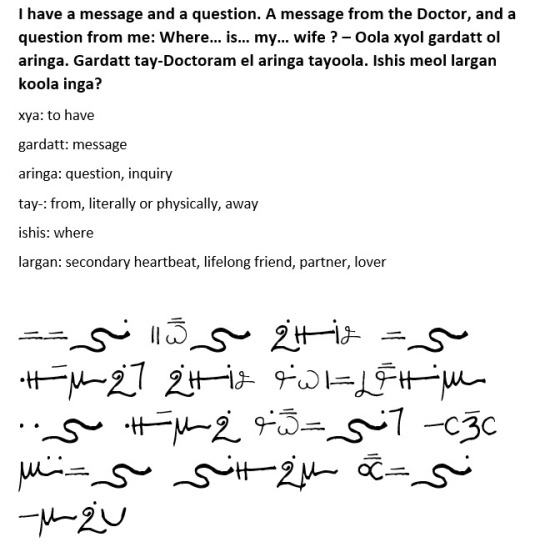
#doctor who#gallifreyan language#teegarden gallifreyan#gallifreyan conlang#doccywhomst low modern gallifreyan#rory williams#11th doctor#good man goes to war#last centurion
12 notes
·
View notes
Text
circular gallifreyan is circular because doctor who is a circular narrative 🌀 when you are a time-sensitive like them you conceptualise everything as a cycle with no beginning or end. including language. which is also music. yay
#simplest meta i have ever posted. also getting plagiarism deja vu i.e. certain i didn’t come up with this but can’t remember who did#dw#doctor who#doctor who meta#gallifreyan#circular gallifreyan#circular narratives#cyclical narratives#storytelling#the narrative#jamie.txt#conlangs#not really i just like attention#eternal return
494 notes
·
View notes
Text
I've spent an inordinate amount of time parsing the few examples we have of Old High Gallifreyan text, and here at last is the result of my labors!
The Old Gallifreyan alphabet:
The alternate forms of letters may be used interchangeably with their main forms; the differences are purely cosmetic, much like the difference between cursive and print-style writing.
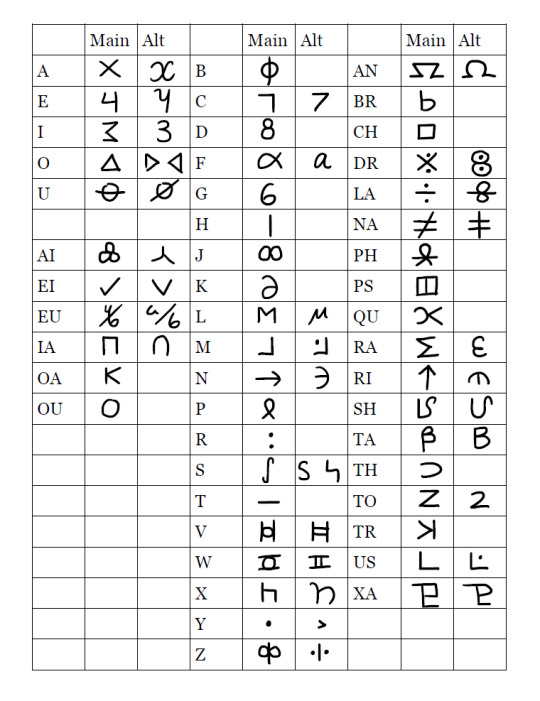
Now for my analysis of the existing texts. It's rather long, so I've put it below the break!
EXAMPLES OF OLD HIGH GALLIFREYAN TEXT
ITEM ONE

Supposedly from “The Five Doctors,” though I can’t spot this writing anywhere. Translation given in episode.

ORA PSYERPA
O – honorific indicating uniqueness, may be rendered with the definite article “the”
R – combined with the definite honorific, a common abbreviation of Rassilon’s name
A – an alternate version of the possessive “ya,” used only when the possessive noun is already abbreviated
Psyerpa – a general term for harps and other large stringed instruments
Thus, the full text reads:
O-Rassilon-ya psyerpa
The Rassilon’s harp
ITEM TWO

From “The Colony in Space,” across the bottom of the Doctor’s mugshot. No translation given.

QU ETHOA TRIOUAX BRIA
Qu – This is not a complete word, merely a letter used in this case for alphanumerical file designation: note that it stands alone, separate from the main text.
Ethoa – exile
Triouax – an infinitive verb, “to persist” or “to remain in effect”
Bria – a conditional modifier used exclusively in bureaucratic contexts, implying the need for occasional update of information or policy.
This text is a record of the Doctor’s sentence, and may be rendered something like this: Exile: to remain in effect barring further review.
ITEM THREE
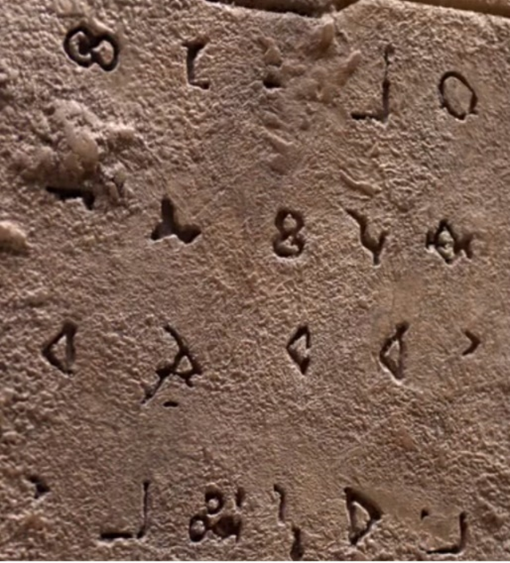
From “The Time of Angels.” Translation given.

JUSYMOU CAIDEU OXA OOYY MAISOM
Jusymou – An archaic greeting, roughly equivalent to “well met” or “hail.”
Caideu – self, soul, or “hearts” in a poetic sense
Oxa – prepositional suffix, “part of”
OOYY – a conceptual abbreviation that combines the two meanings of the solitary letter O (definite article + symbol of individuality) and the mathematical use of the letter Y (usually indicating a dimensional shift). Literally, this means something like the individual, shifted two dimensions. In practice, it refers to a Time Lord’s fifth dimensional aspect.
Maisom – name, designation, identification
Thus, a literal translation would read something like this: Greetings, soul-linked fifth-dimensional name!
Or as the Doctor paraphrases it: Hello, Sweetie.
ITEM FOUR
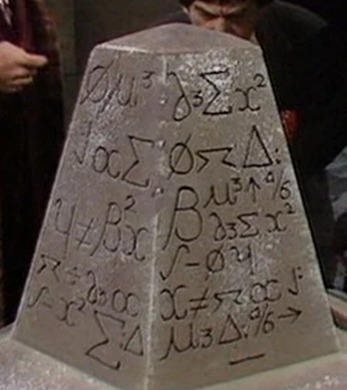
From “The Five Doctors.” Translation is given, though it’s not specified which face of the obelisk corresponds to which section of the text.
First Face:

RA NASA TO TANA EURIFSTAN OBLR ORE NATA
Ra – where
Nasa – sleep
To – in
Tana – lies, reclines, rests
Eurifstan – eternal, endless, timeless. Here it modifies the verb, so it should be rendered as an adverb.
Oblr – abbreviated form of obelar, tomb or grave
OR – the same abbreviation seen previously, “The One And Only Rassilon.”
E – an alternate version of the possessive “ya,” used only when the possessive noun is already abbreviated
Nata – a basic verb of being, is
This yields the following literal translation: Where sleep-in lies eternally, tomb Rassilon’s is.
Or as the Doctor translates it: This is the Tomb of Rassilon, where Rassilon lies in eternal sleep.
Second Face:
The text on the second face is never seen. The Doctor translates it as: Anyone who's got this far has passed many dangers and shown great courage and determination.
Third Face:

ULIREIF RAENATA TOAAN LAKI FSTA TORARO
Ulireif – to lose everything, to be utterly defeated
Raenata – an emphatic form of the being-verb nata, indicating that something really, truly, permanently is
Toa’an – to win everything, to be crowned victor
Laki – a compound conjunction combining la (so) with ki (and): “and so”
Fsta – an abbreviated form of festoa, a winner or leader
Toraro – future tense of torar, to fail or collapse
Thus: To lose all is truly to win all, and so the winner will fail.
Or as the Doctor puts it: To lose is to win, and he who wins shall lose.
Fourth Face:

KIRA ATOUNA OR TA LIRI EUKI RAATO SUTE ANAAN FEIRLIO REUNT
Kira – takes
Atouna – ring
OR – the same abbreviation seen previously, “The One And Only Rassilon.”
Ta – from
Liri – hand
Euki – a compound conjunction combining eu (then, next, afterward) with ki (and): “and then”
Ra’ato – future tense of ra’at, to wear
Sute – reward, prize, payment
Ana’an – desired, sought-after
Feirlio – future tense of feiril, to get or acquire. Note that this is an irregular verb: the last two letters switch places when adding any tense ending.
Reunt – immortality, eternity
Literally: Takes ring Rassilon-from-hand and then will wear, reward-sought will have: immortality.
Or as the Doctor translates it: Whoever takes the ring from Rassilon's hand and puts it on shall get the reward he seeks: immortality.
#doctor who#gallifreyan language#conlang#old high gallifreyan#no I have no idea how many hours I spent figuring this out#yes I'm working on figuring out the modern alphabet too (the one Four uses when he writes his letter at the beginning of Deadly Assassin)
237 notes
·
View notes
Note
What's the longest word in Gallifreyan you're allowed to show us?
Lishatevanagalregowomoxkliakoria /lˈiːʃətˈɛvanˈaɡə͡lɹˈe͡ɪɡə͡ʊwˈə͡ʊmˈɒksklˈi͡əkˈɔːɹiə/
↪ Definition: That feeling you get when you accidentally land in a time period where your future self already exists and you have to explain why you look so familiar, knowing it's inevitable you'll fail in this and end up having a memory wipe, but you look forward to remembering this encounter in the future so long as you survive it.
Hope that helped! 😃
-------------------------------------------------------
》📫Got a question / submission?
》😆Jokes |🫀Biology |🗨️Language |🕰️Throwbacks |🤓Facts
》📚Complete list of Q+A
》📜Masterpost
If you like what GIL does, please consider buying a coffee to keep this human conscious and help make future projects, including complete biology and language guides.
#doctor who#gil#gallifrey institute for learning#dr who#gallifrey#gallifreyans#ask answered#whoniverse#dw eu#conlang#GIL words
54 notes
·
View notes
Text
Been learning gallifreyan for the funzies this shit is ADDICTING it’s SO FUN and there’s so much possible variation
First attempt (my name)

How I would imagine Theta writes Koschei’s name - his adhd ass is not sitting still to write it down neatly lol

How Koschei writes Theta’s name, he on the other hand has very good handwriting, from what I understood his family is p strict so I feel like they’d make him write properly lol

And then this is my magnum opus (so far)
I picked the longest word I could think of, so long in fact I had to use a mini word circle in the bigger one bc otherwise it wouldn’t have fit lol

For those who are interested, I used this guide:
EDIT: for anyone reading this post I’ve got a gallifreyan project I’ve finished so if you’re interested, check out my blog :]
#how the fuck did Time Lords just write like this#no wonder they invented time travel and were able to bend dimensions#they would’ve needed time travel bc this shir takes so long to write#and to be able to warp dimensions so they never ran out of space in the words lol#dr who fanart#dw#thoschei#gallifrey#gallifreyan#conlang#Autumn’s art tag
94 notes
·
View notes
Text
Introducing: The Linguist's Phonetic Gallifreyan


This is a modification of Brittany G.'s Doctor's Cot Gallifreyan, which reorganized the layout of the Consonants and Vowels tables, adjusted how punctuation works, and added two new mechanics for quality of life. Its full title is The Linguist's Phonetic Gallifreyan, but the shorthand, for lack of a better idea, is GalliPhon. Interested to know the details? Read on!
I started working in Doctor’s Cot a few months ago. It’s interesting, and a fun change of pace from Sherman’s Circular, but it has a few flaws that have really started to dig at me. Firstly, despite the system being made to represent any language, it still is clearly made with English in mind. Nearly all English consonantal sounds are contained in the top left corner of the consonant table. While it does not bother me all that much that the system is made with English as the primary use — I do primarily use Sherman’s Circular, after all — it leads to all the consonants looking samey, and the layout feeling otherwise purely random. In a similar vein, all the English consonants being clustered together led to a lot of indistinguishable consonant pairs. I have dealt with this by leaving lines unconnected on one side, or dots attached to their corresponding circle, but this feels cheap, as Brittany did specify that indistinguishable consonants should be separated into new circles, which I find tedious and aesthetically displeasing. Another problem with the layout is that א’s circle ends up being a pain to make every time I need to write a word that starts with a vowel. For these reasons, I decided to reorganize the charts to have a more logical layout. And, while I was at it, I modified the formulation of punctuation to accommodate more punctuation marks and added two new mechanics to make formulating words less tedious: diphthong bridges and the reversal dot. As a warning, this is NOT a guide to the use of Phonetic Gallifreyan. To learn how to play, I would recommend checking out Brittany’s walkthrough, using my charts instead of the Doctor’s Cot ones.
The Consonant and Vowel Charts
They are now loosely organized based on the IPA categorizations in the 2020 chart. Broadly speaking: a single thin line corresponds to trills, taps, and approximants; double thin lines corresponds to laterals; a thin outer line and thick inner line corresponds to unvoiced fricatives; a thick outer line and thin inner line corresponds to voiced fricatives; double thick lines corresponds to nasals; and a single thick line corresponds to plosives. And for decorations (going from left to right in the chart because they are hard to describe): alveolar, retroflex, postalveolar, dental, “other symbols,” pharyngeal and glottal; labiodental; bilabial; uvular; velar; and palatal. The symbols do not always correspond exactly, but that’s the general organization I worked off of. For the vowels, I went easier on myself and organized them mostly by the English vowels, left-to-right O, U, A, I, and E. Additionally, as there are 28 base IPA vowel sounds but 30 spaces, I included the two most common diphthongs, ai and au. However, as I now have an option to make diphthongs, these are not recommended for use.
Diphthongs
I have added a function that will allow you to have two vowel sounds in a single circle, but only if they are part of a diphthong. Distinct vowel sounds must be in different syllable circles, even if there is no consonant between them. Two vowels in a dipthong, however, may be connected by a diphthong bridge, a line leading from the edge of the first vowel to the middle of the second. An example of both a diphthong and a still separate vowel can be seen in Ohio: /oˈhaɪ o/
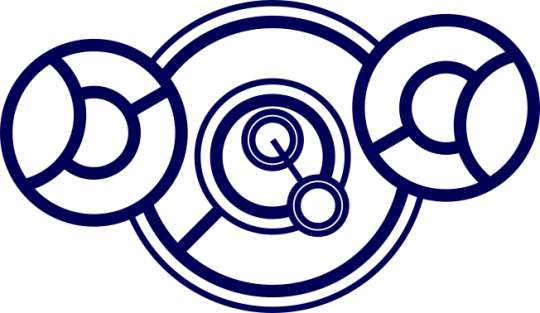
Vowel/Consonant Reversal
The other function I am adding is the reversal dot, necessitated by how annoying it is that words like “is,” “and,” and “or,” require two circles despite their simplicity. So, in Phonetic Gallifreyan, you can add a filled dot to the center of a word circle to indicate it should be read vowel first. Consonants still go outer circle first, then inner circle. As an example: “and” /ænd/

Punctuation
The primary change is that they don’t consist of two circles, just one. This way, a limited pool of punctuation can be combined to create more punctuation, like combining a period and a comma to make a semicolon, or three periods to make an ellipsis, or even some rarer punctuation like the interrobang (‽)

Credit to Brittany G. for the basis, and to Wikipedia and Phoible for research on IPA, punctuation, and more.
#UPDATED MARCH 27 2023#if you are translating any GalliPhon posted before this date you will get ɤ where ʊ was intended#the ʊ ɯ and ɤ vowels have been moved (essentially clockwise)#(mainly bc I was getting annoyed at how much space the oʊ dipthong took up)#also apologies for how terrible this all looks#unlike Brittany I am far from being a graphic designer#GalliPhon#gallifreyan#doctor who#The Linguist#conlang
182 notes
·
View notes
Note
You might have already answered this before but I just started reading your Gallifreyan guide and dictionary!(I love it so much btw! It’s so cool and I’m seriously geeking out about it)
I was wondering how you chose each companions name in Gallifreyan? Was it just whatever sounded good or was there a particular thought process you went through (like this name means this in English so the Gallifreyan translation would be a word that’s similar in meaning)?
Oh hi! Oh really happy you're enjoying it, and I can certainly answer this one ...
There are a couple of names that already exist in Who lore (meyopapa, arkytior), so they stayed, though when it comes to other names, there is a slight bit of my own headcanon at play.
The language is more of a post-Time War language that's constantly being added to by the Doctor, so when creating a name the idea is that the Doctor's making up the words, putting together a kind of 'trait' and a suffix to describe the person.
Rolas for Jack uses 'rol' as a stem, which forms words like help/rescue/protect/warn
Jarbai for Martha uses 'jar', forming words like repair/heal/reattach
Klayya for Donna uses 'kla', forming words like trust/share/rely
To be honest, the language has evolved so much (as a language should) that those meanings have gotten slightly scattered and probably don't come through anymore, but it was never meant to be a rule anyway, just a subtle nod. I may or may not correct this for version 2; we'll see.
There's a question I was never expected to be asked and I enjoyed answering it immensely, thanks! :D
8 notes
·
View notes
Text

the undertale quote in circular gallifreyan
#gallifrey#gallifreyan#circular gallifreyan#undertale#writing#conlang#doctor who#despite everything its still you
4 notes
·
View notes
Text
Romanizing Gallifreyan
By marzattlindexsvateegardon (The Attlind)
I am far from the first to try and romanize moden Gallifreyan for earthly audiences (English, predominantly) such as the Wilderness Years novelists and even on-screen appearances since the series reboot. While I would love to adhere to one popular standard or another, the myriad of dialects and linguistic time periods I am trying to reconcile into one vaguely coherent archive, I've had to make a few compromises, several of which admittedly favour my own home dialect of Wugharigan.
Word division
3 words minimum per clause, strict subject/verb/object division. In some dialects such as Tapraliphan, whole-clause words are common due to their use of the Sheramn (collared) circular script; this is commonly seen in the ancestral names of Tapraliphan Time Lords, such as darkelatraquistahastrad, which would be written here as dar kelatra quistah astrad*.
*Note: this is very archaic Gallifreyan and would be written differently as a modern title: darex kelatra quisteda kelastrad.
Some former romanizations (mostly from human linguists at UNIT) include the particle division of some Enaslabreg texts - the southernmost Enaslabreg dialect existed purely as a logography for millenia before being transliterated by neighboring Tapraliphan tribes into circular script, with the resulting particle clusters often being interpreted similarly to romanized Korean: Gallifrey's secondary sun sometimes being written as payma-ngawa-fry to aid those familiar with Enaslabreg text. With the exception of place and person names, Enaslabreg-derived words will be written unbroken [paymang(k)awafry]
Numerals
The Tapraliphan decimal system will be used for its ease of comparison to the metric system. As such, hyphens will be used in the same order as UNIT standard [100-000-00-0]
Phonology
Written Gallifreyan, as a phonetic language, varies in spelling between region and dialect. For any words with contested pronunciation, the Wugharigan equivalent will be used, except in situations where the word is of greater or sole significance to another dialect.
eg. arkyti is used over the Tapraliphan arakeetha
Double vowels are retained in words formed by compounding [gena-alic] or where their usage is ubiquitous even within Wugharigan phonology [tee]
I realize much of this might not be particularly relevant to many, but it is important to me as a historian to ensure that the changes I make in the name of accessibility do not discourage readers from using a historical lens.
#gallifrey#headcanon#teegarden's gallifrey#worldbuilding#teegarden gallifreyan#classic doctor who#nuwho#conlang#fandom#roleplay
6 notes
·
View notes
Text
I'm not saying I want to make a Gallifreyan conlang...but I am saying the concept of an omnipresent tense kept me up half the night.
#doctor who#conlang#gallifreyan#this wouldn't be their only tense obviously but ooh what fun#oh! what if there's a tense for things that end and then things that don't end?#actually that would probably be better as a noun class..hmm#i don't have time to think about this right now but i am Intrigued
7 notes
·
View notes
Text
So, I tried to translate what was in the new sonic screwdriver with the Sherman's Gallifreyan.

And it's a bunch of non sense, it thanslates to "the bonguj fgifeet the nefechachp fa the otshavvi the bepnefeba fa".
There are some letters that are ambiguous "the bonguj fgife(e?)t the nef(e?)chachp f(a/e?) the otsha(vi/vvi?) the b(e?)pnef(e?)b(a/i?) f(a/e?)".
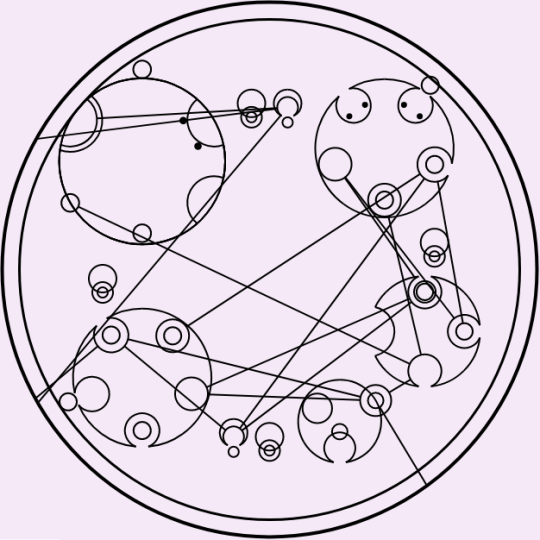
Taking the frase that is ment to be "the sharpness of the tongue defeats the sharpness of the warrior", the writing becomes:

Which is doesn't looks like the sonic, just the 4 "the"s that are equal, and it's supposed to be written in Kinyarwanda, also known as Ikinyarwanda or Urunyarwanda, that's the language spoken in Rwanda, but the meaning that the show gives us translates to "ubukana bwururimi butsinda ubukana bwintwali".
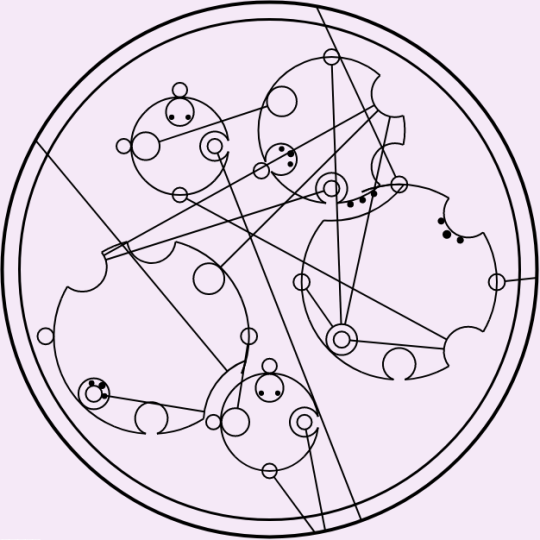
Which is nowhere close to the writing in the sonic.
With that said, I think the people who made the sonic searched a little in the fandom for our way to write in gallifreyan and then took what they found pretty and merged together because it looks like gallifreyan and the system is 99% Sherman's Gallifreyan but there are some discrepancies.
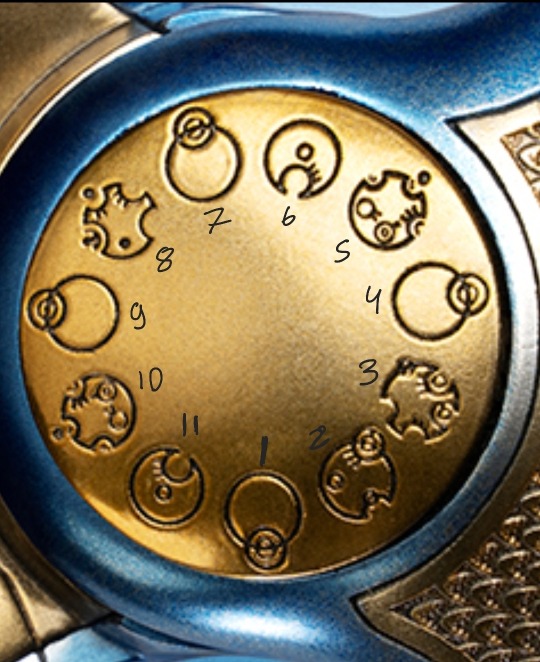
If you look in the second symbol what was supposed to be "ngu" is written wrong, the circle has 4 lines but the maximum amount is 3, I consider that to be "ng" + "u" because normally we would merged together the line of the "u" with another symbol of take it to the border or merged it with one of the lines in the "ng".
You can see as well in the third that between the "fe" and the "b" there's something, I read that as and "e" but it doesn't really makes sense if you consider that it has before it another "e", when there are doubles of a letter we just make it twice.
The sixth and eleventh are equally strange, it seems to be an "f" with something, it could be an "o" but it's too big and not close enough to the border, the only one I could think that its close enough it's the "a", because it's quirk is that it's always far but for the outside, this one is "far" but for the inside.


The eighth it's as well interesting, in what was supposed to be a "vi" the way is written makes it look live a "vvi". And the last, the tenth has what looks like a "ba" but looks like it has a dot in it but there aren't any single dots only two or three dots, so I just ignored it.
And I'm not even gonna talk about the slashed "e"s because that formed a pattern and I just assumed it's on propose.
In conclusion, or I'm dumb and can't read or they just put something inspired in the Sherman's Gallifreyan to look pretty and make us go slightly crazy but in the end it's just the the normal gallyfean that doesn't means a single thing.
Ps: sorry for any wrong words or terms, I'm brazilian and my english isn't perfect.
EDIT: I'M DUMB, thank you @mesimees and @typeforty for explaining the actual way of reading this, @mesimees rebloged this with a pretty simple explanation on how really to read this, thank you for the correction and it's really fucking awesome to discuss conlangs linguistics
#doctor who#dw#14th doctor#15th doctor#fifteenth doctor#fourteenth doctor#sonic screwdriver#the new sonic screwdriver#new sonic screwdriver#i'm going insane#this show will be the death of me#this show will be my ruin#linguistics#doctor who linguistics#gallifrey#gallifreyan#Sherman's Gallifreyan#ncuti gatwa#i'm too autistic for this
65 notes
·
View notes
Text
Говорим по-галлифрейски.
Ru: "Я буду всего лишь историей у тебя в голове. Но это ничего. Мы все, в конечном итоге, истории. Только пусть это будет хорошая история. Потому что это и была хорошая история. Самая лучшая. Сумасбродный старик, который стащил волшебную будку и улетел. Я сказал, что украл её? Нет, я её одолжил. Собирался вернуть обратно."
En: “I'll be a story in your head. That's okay. We're all stories in the end. Just make it a good one, eh? 'Cause it was, you know. It was the best. The daft old man who stole a magic box and ran away. Did I ever tell you that I stole it? Well I borrowed it. I was always going to take it back.”
Gllfr: "Ooza melind basteres kala. Isam melesh. Oolafrey melindey bastoclaam. Klozek eri ila anyazec. Jen ina meon, ala mendol. Ina meon ehabrill anya. Magul ipsayan malisketham exis ongakvalon garezux syko el umiphon. Inga oota dyayoton ata isam oona ongakvalon ira? Shye, oona tugekvalon ira. Oona igrekonor zleneph ira."
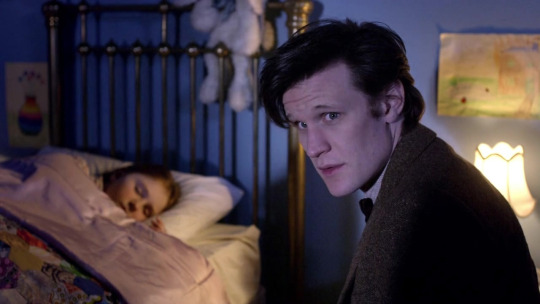
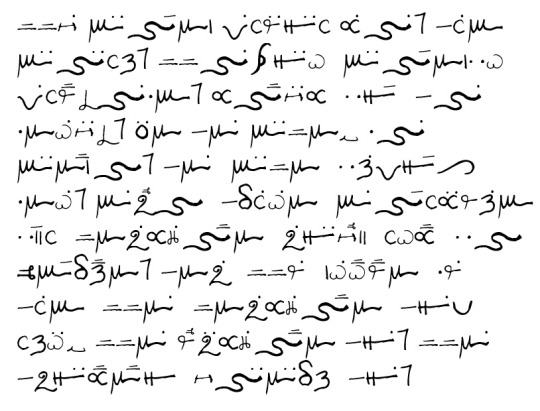
#teegarden gallifreyan#gallifreyan language#gallifreyan conlang#doctor who#doccywhomst low modern gallifreyan#amy pond#eleventh doctor#11th doctor#matt smith
2 notes
·
View notes
Note
Any tips on making a alphabet for a made up language
With respect to conlangers, y’all are stronger than me, if I have to look at an IPA chart again I’ll burn something
Step 1. Identify the vibe of your language. Is it scifi, historical, alien, fantastical, inspired by any particular existing language or culture, ect? Is it affected by the writing tool (quill, stylus, brush, light beam)?
Step 2. Develop intense hatred for a canon alphabet in your chosen niche. Spite will carry you on when passion doesn’t

Galarian script is better, thank fuck
Step 3. Keep it simple but don’t worry too much about distinctive characters. We have N and M, Л and Д, it’s realistic if some characters are just others flipped, mirrored, or with an added dot

E and L are mirrored characters. 20 years and no complaints
Step 4. Translate stuff. You could go with letter by letter, syllablic blocks (see: korean), heiroglyphs, IPA (why), character that looks closest to latin characters (one of the inkling writing methods), or sth way out there like circular gallifreyan or musical notation

An example of Inkling mimicked script. The word TOWER if translated would be QW_JA. Inkling has like a dozen different scripts and the devs have a brilliantly practical approach to conlanging

Some symbols from Rainworld. It doesn’t have a concrete language system but the characters frequently used (danger, food, shelter, survive) are consistent
Step 5. Troubleshoot your alphabet. If a character looks too busy or just doesn’t fit, ditch it and use something else
259 notes
·
View notes
Text
How to Come Up with Time Lord Names
Sooooo...I did a letter-by-letter analysis of 230 names from the wiki's list of Time Lords, making sure I only chose characters that both 1) had names that sounded like part of the same language and 2) had their jobs listed so I could correlate name-segments with talents.
If you want to see my whole headcanon about how Time Lord names work and what each syllable means, I've put it on AO3. If you just want to know what sounds and syllables to include when you're coming up with names, the analysis I did of all those existing names is below the cut.
Most syllables consist of a consonant followed by a vowel.
A syllable can only contain one vowel (with the exception of IA, which acts like a single vowel).
Every syllable contains at least one consonant (with the exception of O, which can stand alone without a consonant attached).
About 46% of analyzed syllables add a second consonant after the vowel. About 18% of analyzed syllables follow a vowel-consonant pattern. Only nine consonants are used after vowels. (C/K/Ch, D, F/Ph/P, L/LL, M/N, R, S/Sh, T/Th, X)
Total names analyzed: 230
Total syllables in analyzed names: 719
Number of syllables based around each vowel:
A 295 (36% 0f analyzed syllables)
E 129 (18% 0f analyzed syllables)
O 127 (18% 0f analyzed syllables)
I 118 (16% 0f analyzed syllables)
U 50 (7% 0f analyzed syllables)
Number of syllables beginning with consonants: 592 (82% of analyzed syllables)
Number of syllables beginning with each consonant:
R 77 (11% 0f analyzed syllables)
T 70 (10% 0f analyzed syllables)
L 68 (9% of analyzed syllables)
N 46
S/Sh 40
V 42
C/K/Ch 41
D 40
M 32
G 21
P 21
B 14
Tr 13
H 12
Dr 10
Br 7
F/Ph 6
J 6
X 6
Z 5
Fl 3
Sp 3
Qu 3
W 2
Y 2
Number of syllables beginning with vowels: 127 (18% of analyzed syllables)
Number of syllables beginning with each vowel:
A 61 (8% of analyzed syllables)
E 24
O 19
U 16
I 7
Number of syllables ending with consonants: 332 (46% of analyzed syllables)
Number of syllables ending with each consonant:
M/N 102 (14% of analyzed syllables, 31% of syllables ending with consonants)
R 67 (9% of analyzed syllables, 20% of syllables ending with consonants)
S/Sh 52 (16% of syllables ending with consonants)
L/LL 43 (13% of syllables ending with consonants)
X 22
C/K/Ch 15
T/Th 14
D 12
F/Ph/P 5
Most Commonly Used Syllables:
An (15 times)
Na (15 times)
Ra (15 times)
Ri (14 times)
Ta (14 times)
La (13 times)
Ro (11 times)
Sa (11 times)
Us (11 times)
Ti (10 times)
All other syllables appeared fewer than ten times in the analysis.
#doctor who fanfic#statistical analysis#gallifreyan language#conlang#I'm probably insane for doing this#but I hope it helps someone
20 notes
·
View notes
Note
This is gonna sound soppy, how do you say 'I love you' in Gallifreyan?
Ei shamui eon. /ɐ ʃˈɑːmjˈuːi ˈiːɒn/
↪ I love you.
Some variations:
Ei wiShamui eon. = I love you (in a 'I literally can't exist without you' way)
Ei aiShamui eon. = I love you (in a completely polite and appropriate way).
WiEi shamui eon. = I love you (in an unhealthy overbearing way).
AiEi shamui eon. = I love you (in a submissive way).
Ei'shamui eon! = I am loving you! (right now here in this moment)
Hope that helped! 😃
-------------------------------------------------------
》📫Got a question / submission?
》😆Jokes |🫀Biology |🗨️Language |🕰️Throwbacks |🤓Facts
》📚Complete list of Q+A
》📜Masterpost
If you like what GIL does, please consider buying a coffee to keep this human conscious and help make future projects, including complete biology and language guides.
#doctor who#gil#gallifrey institute for learning#dr who#gallifrey#gallifreyans#ask answered#whoniverse#conlang#GIL words
23 notes
·
View notes
Text
other fandoms: some conlangs, some lore
doctor who fandom: I Know What Gallifrey’s Atmosphere Is Made Of And How To Write An Essay In Gallifreyan
12 notes
·
View notes